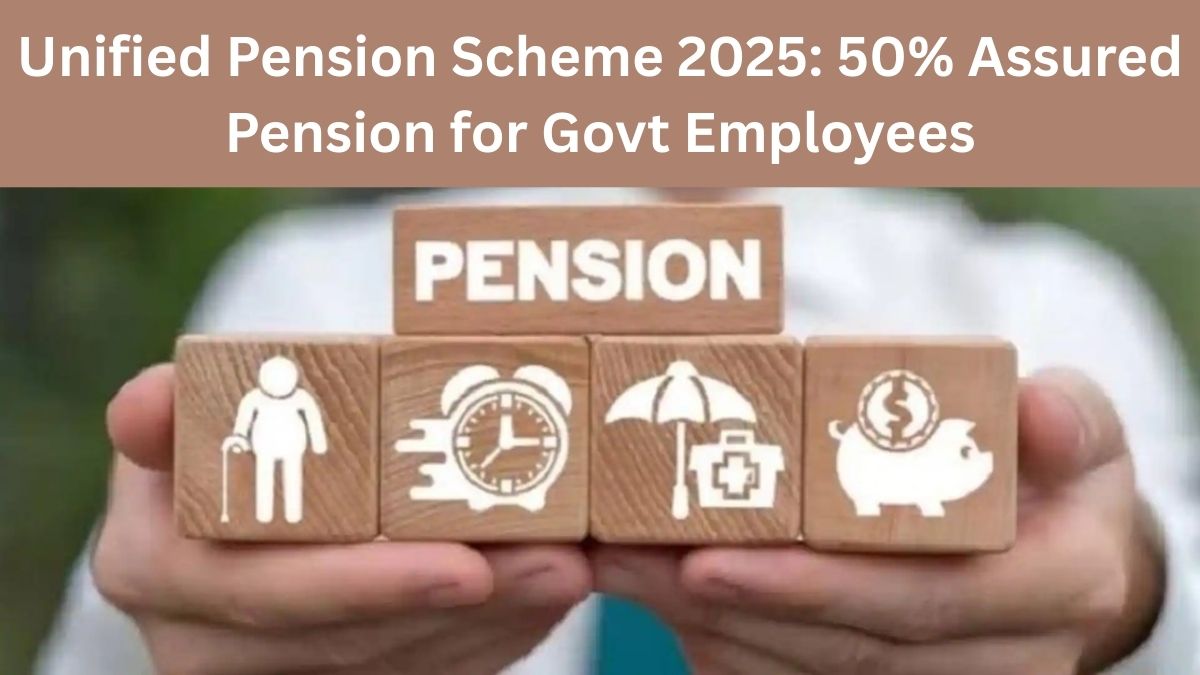The Indian government has approved a transformative step in the country’s retirement benefits system — the Unified Pension Scheme 2025. This groundbreaking initiative guarantees a 50% assured pension of the last drawn basic salary for central government employees, aiming to bring stability, predictability, and long-term social security in place of the market-linked National Pension Scheme (NPS).

What is the Unified Pension Scheme 2025?
The Unified Pension Scheme 2025 is a newly proposed pension policy designed to offer guaranteed post-retirement income to government employees. It replaces the uncertainty of NPS with a clearly defined benefit structure. Unlike the previous system where pension returns were subject to market risks, this scheme ensures that eligible employees will receive 50% of their last basic pay as pension, regardless of market fluctuations.
Key Features of the New Pension Policy
The shift to a defined benefit scheme underlines the government’s commitment to strengthening central government pension benefits. Here’s what sets the Unified Pension Scheme apart:
Guaranteed Pension:
Eligible employees will receive 50% of their last basic salary as a guaranteed pension after retirement.
Applies to Central Govt Employees:
This scheme is currently applicable to employees under the central government, including ministries and departments.
Implementation Timeline:
The policy is scheduled for rollout starting April 1, 2025, as per the Union Cabinet’s approval.
Replacement of NPS:
The scheme is likely to apply to central government employees who joined service after 2004 and were earlier under the National Pension Scheme.
Unified Pension Scheme vs NPS
To understand the significance of this shift, here’s a comparative table:
| Feature | Unified Pension Scheme 2025 | National Pension Scheme (NPS) |
|---|---|---|
| Type of Pension | Defined Benefit | Market-linked Defined Contribution |
| Pension Amount | 50% of last basic pay (assured) | Based on market performance |
| Government Contribution | Fixed | Variable (as per fund performance) |
| Applicability | Central government employees | Central & state govt employees + public |
| Financial Risk | Government bears the risk | Employee bears market risk |
| Pension Security | High | Moderate to Low (market dependent) |
Why Is This Scheme Important for Assured Pension in India?
The Unified Pension Scheme 2025 arrives at a time when inflation, rising healthcare costs, and increasing life expectancy are making retirement planning more complex. With the new scheme:
-
Retirees will no longer face pension volatility.
-
It ensures peace of mind for government employees nearing retirement.
-
It sets a precedent for future pension models in India, especially for states looking to follow suit.
Moreover, the scheme is being seen as a political and social win, addressing growing demands for restoring defined benefits and reducing income insecurity in old age.
Challenges and Concerns
While the policy has been welcomed by employee unions and pensioners’ associations, economists have raised concerns about its long-term fiscal sustainability. Funding a non-contributory or low-contribution defined benefit scheme could strain government budgets if not managed carefully.
However, the government has assured that actuarial studies and phased implementations will ensure financial balance without overburdening the exchequer.
Future Outlook for Central Government Pension Policies
The Unified Pension Scheme 2025 could trigger a shift in India’s pension policy landscape. Several state governments have already expressed interest in similar reforms. The scheme may also open dialogue around assured pension in India for unorganised sector workers and contractual staff, many of whom lack adequate retirement coverage.
FAQs
Q1. Who is eligible for the Unified Pension Scheme 2025?
Employees working under the central government, especially those who joined after 2004 under NPS, are likely to be covered.
Q2. Will the new scheme apply to state government employees?
As of now, the policy is limited to central government employees. However, states may choose to adopt similar models based on feasibility.
Q3. What happens to employees already under NPS?
The government may offer them an option to switch or integrate based on service tenure and financial models.
Q4. Is 50% pension calculated on total salary or just basic pay?
The assured pension is calculated on the last drawn basic pay, not total gross salary.
Q5. When will the scheme come into effect?
The rollout is expected to begin from April 1, 2025, following necessary administrative procedures.
Click here to know more.
Kishan is a knowledgeable writer specializing in agriculture and the latest government job recruitments, delivering clear and insightful content to inform and empower readers.
